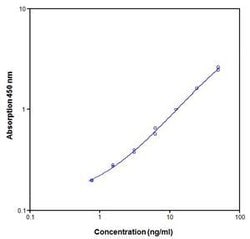Learn More
Invitrogen™ Human CD137 (4-1BB) (Soluble) ELISA Kit
ELISA

$636.65 - $4748.65
Specifications
| Accession Number | Q07011 |
|---|---|
| Assay Range | 0.78 to 50 ng/mL |
| Assay Sensitivity | 0.2 ng/mL |
| Conjugate | HRP |
| Product Type | ELISA |
Includes: Aluminium pouch(es) with a Microwell Plate coated with monoclonal antibody to human sCD137
Biotin-Conjugate anti-human sCD137 polyclonal antibody
Streptavidin-HRP
Human sCD137 Standard lyophilized, 100ng/mL upon reconstitution
Sample Diluent
Assay Buffer Concentrate 20x (PBS with 1% Tween 20 and 10% BSA)
Wash Buffer Concentrate 20x (PBS with 1% Tween 20)
Substrate Solution (tetramethyl-benzidine)
Stop Solution (1M Phosphoric acid)
Blue-Dye
Green-Dye
Red-Dye
Adhesive Films
Description
The Human Soluble CD137 (4-1BB) (Hu CD137) ELISA quantitates Hu CD137 in human serum or cell culture medium. The assay will exclusively recognize both natural and recombinant Hu CD137. Principle of the method The Human CD137 solid-phase sandwich ELISA (enzyme-linked immunosorbent assay) is designed to measure the amount of the target bound between a matched antibody pair. A target-specific antibody has been pre-coated in the wells of the supplied microplate. Samples, standards, or controls are then added into these wells and bind to the immobilized (capture) antibody. The sandwich is formed by the addition of the second (detector) antibody, a substrate solution is added that reacts with the enzyme-antibody-target complex to produce measurable signal. The intensity of this signal is directly proportional to the concentration of target present in the original specimen. Rigorous validation Each manufactured lot of this ELISA kit is quality tested for criteria such as sensitivity, specificity, precision, and lot-to-lot consistency. See manual for more information on validation.
CD137, also known as TNFRSF9 or 4-1BB, is an inducible costimulatory molecule expressed mainly on activated T cells. Its ligand, known as 4-1BBL, is expressed on activated macrophages, mature B cells, hematopoietic stem cells, and myeloid progenitor cells. CD137 signaling leads to maintaining the survival of activated T cells and CD8+ memory T cells, and clonal expansion of T cells, but also to suppressing myelopoiesis and dendritic cell development. Triggered CD137 induces a cytokine release profile regulating peripheral monocyte survival. Soluble forms of CD137 may provide negative control mechanism for some immune responses.Specifications
| Q07011 | |
| 0.2 ng/mL | |
| ELISA | |
| Human | |
| Colorimetric Microplate Reader | |
| 4-1 BB,CD137,CDw137,ILA | |
| 7.1 | |
| HRP | |
| Serum 50 μL, Supernatant 50 μL | |
| 4-1 BB Ligand Receptor, TNFRSF9, ILA | |
| 1 hrs 20 mins |
| 0.78 to 50 ng/mL | |
| HRP | |
| Serum, Supernatant | |
| ELISA | |
| 3604 | |
| 9.9% | |
| Pre-coated 96 well plate, Standard, Sample Diluent, Assay Buffer concentrate, Biotinylated Detection Antibody, SAV-HRP, Wash Buffer, Chromogen, Stop Solution, Adhesive Plate Covers | |
| RUO | |
| 2°C to 8°C | |
| 4-1 BB (CD137) | |
| 3 hrs 10 mins |
The Fisher Scientific Encompass Program offers items which are not part of our distribution portfolio. These products typically do not have pictures or detailed descriptions. However, we are committed to improving your shopping experience. Please use the form below to provide feedback related to the content on this product.



